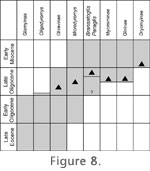|
|
DISCUSSIONOligodyromys (group 1)The small Eocene and Lower Oligocene species of Bransatoglirinae have moderately to strongly concave upper and lower molars. As the name indicates, Oligodyromys planus is supposed to have relatively flat molars but it possesses moderately concave molars. Within this group O. sjeni possesses the strongest concave molars, and O. attenuatus possesses the least concave ones. The lower molars are less concave than the upper ones. Bransatoglis/Paraglis (group 2)These large species from the Upper Oligocene and Miocene have the same range of concavity as the previous group, in general, moderately concave. The M2 of P. fugax is strongly concave, and data for the other elements are not available. The M2 of B. concavidens is strongly concave, but not much more than O. planus; the value obtained may be exaggerated, because wear seems to affect more the center of the tooth than the labial and lingual border. Its M1 is only weakly concave, and its M2 is moderately concave (the very high value for m2inf_post of B. concavidens is misleading, because the profile had to be drawn over the posterolophid). Microdyromys (group 3)This group may be defined as weakly to moderately concave, clearly less than the previous groups. The posterior profile of M2 is an exception in being strongly concave in various cases. The lower molars are clearly less concave than in the previous two groups, and less concave than the upper ones. Like in the case of B. concavidens, m2inf_post is strongly concave in one case (M. misonnei from HB), due to the fact that the posterolophid was drawn instead of the line over hypoconid-entoconid. Dryomyinae (group 4)Concavity has a very wide range, from weakly to strongly concave, both in the group as a whole and intragenerically: Eliomys intermedius is among the most concave Gliridae, whereas E. truci has molars that are only weakly concave. Upper and lower molars have about the same degree of concavity. Glamyinae (group 5)Glamyinae have moderately to strongly concave molars with relatively little variation. Generally the lower molars are more concave than the upper ones. Gliravinae (group 6)The upper molars are moderately to strongly concave. In the lower molars, the profiles are almost flat in Gliravus majori, and very strongly concave in Butseloglis, especially B. itardiensis. This indicates a completely different mechanism of occlusion and mastication between both species. It is not clear whether this may have taxonomic consequences. Glirinae (group 7)Though our data are scarce, molars of Glirinae may be defined as only weakly concave. However, Glis guerbuezi has much stronger concave molars, to such an extent that one should seriously doubt, whether its classification as a Glirinae is correct. Vianey-Liaud (2004) figured two anterior profiles of M2 of Glirudinus antiquus. One of these is weakly concave (ITD 316, Figure 2j3), the other one is moderately concave (ITD 331, Figure 2u3); the difference between the two is large, and one might consider whether ITD 331 is a Microdyromys; the size distribution of G. antiquus partly overlaps that of the contemporaneous M. misonnei from MLB1D. Myomiminae (group 8)Myomiminae have molars that are generally weakly to moderately concave, but with a very wide range of variation, and a few cases even possess strongly concave upper molars. The lower molars are nearly always less concave than the upper ones. Cocavity through TimeIn Table 12 the eight glirid groups are characterized by the concavity of their molars. Concavity does not give an absolute distinction between groups, but it does serve to characterize the groups.
Moderate concavity occurs in all groups. Strong concavity, considered to be the original situation, is absent or doubtful in Glirinae and Myomiminae, which appear to be the most advanced groups. Oligodyromys planus, weakly concave according to the original description, must be characterized as moderately concave. Bransatoglis concavidens is strongly concave indeed, but only in its M2. An objective definition of concavity may have taxonomic consequences at supraspecific level, but it is too early for that. In spite of the large amount of data, 500 profiles distributed over 60 species, the vast majority of the species is represented by one specimen per dental element only. An unknown factor is the relation between concavity and occlusion. In some cases strongly concave upper molars come with strongly concave lower ones, but in other cases they combine with almost flat lower molars. Their occlusion and mastication process must be quite different. Analysis of the population of Butseloglis itardiensis from OLA4A shows that the variation within a sample is reasonable, but analysis of 15 profiles of the same specimen of Oligodyromys libanicus from MLB8 reveals a fairly large error, probably due to orientation of the specimen. It is advisable to draw each specimen several times and use the mean values obtained from these drawings. That will reduce the error considerably. Though the calculations are completely objective, the orientation of the specimen inevitably has a subjective factor that may have considerable influence on the results. |
|
